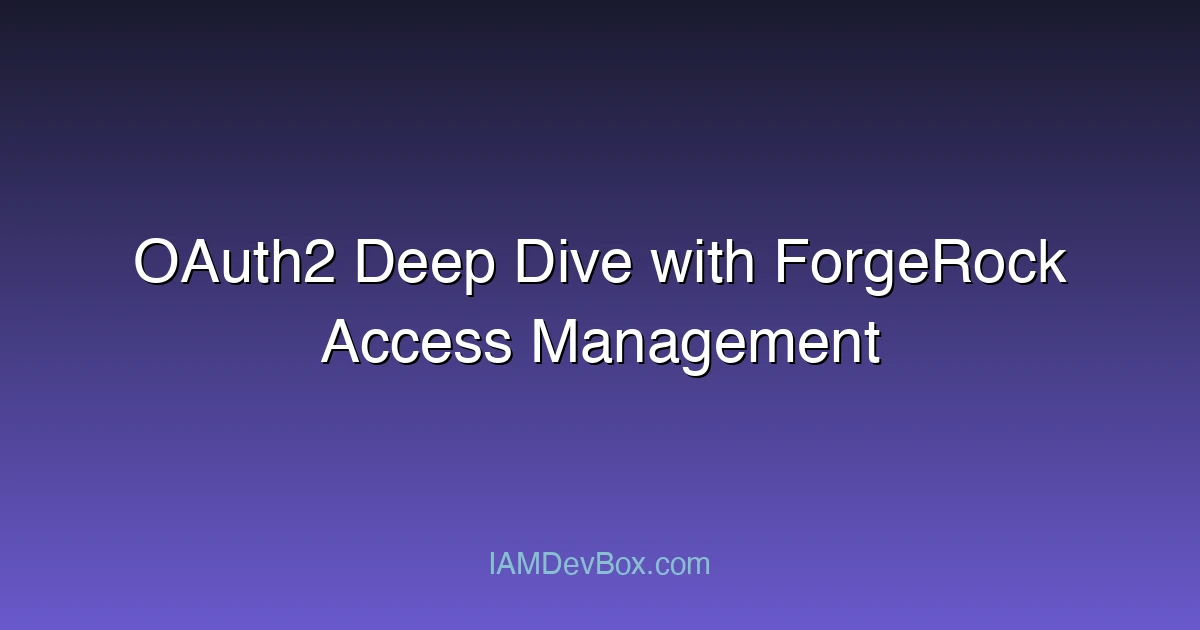OAuth2 has become the de facto standard for authorization in modern web applications, and ForgeRock Access Management (AM) is a leading platform for implementing OAuth2-based solutions. In this article, we will dive deep into OAuth2, explore its architecture, and demonstrate how it integrates with ForgeRock AM.
Visual Overview:
sequenceDiagram
participant User
participant App as Client App
participant AuthServer as Authorization Server
participant Resource as Resource Server
User->>App: 1. Click Login
App->>AuthServer: 2. Authorization Request
AuthServer->>User: 3. Login Page
User->>AuthServer: 4. Authenticate
AuthServer->>App: 5. Authorization Code
App->>AuthServer: 6. Exchange Code for Token
AuthServer->>App: 7. Access Token + Refresh Token
App->>Resource: 8. API Request with Token
Resource->>App: 9. Protected Resource
What is OAuth2?
OAuth2 is an authorization framework that enables third-party applications to access user resources without sharing credentials. It is widely used for scenarios like single sign-on (SSO), delegated access, and API protection. OAuth2 operates on the principle of “tokens,” which are used to grant access to protected resources.
OAuth2 Architecture
The OAuth2 architecture consists of four main roles:
- Resource Owner: The user who owns the resources.
- Client: The application requesting access to resources.
- Authorization Server: Issues access tokens to the client after authenticating the resource owner.
- Resource Server: Protects the resources and validates access tokens.
Here’s a textual representation of the OAuth2 flow:
flowchart LR
N0[Resource Owner] --> N1[Authenticates with Authorization Server]
N2[Client] --> N3[Requests Authorization Code]
N4[Authorization Server] --> N5[Issues Access Token]
N2[Client] --> N6[Uses Access Token to access Resource Server]
N7[Resource Server] --> N8[Returns Protected Resource]
style N0 fill:#667eea,color:#fff
style N8 fill:#48bb78,color:#fff
OAuth2 in ForgeRock Access Management
ForgeRock AM provides a robust implementation of OAuth2, enabling organizations to secure APIs, web applications, and microservices. Let’s explore how OAuth2 is configured and managed in ForgeRock AM.
Configuring OAuth2 Clients in ForgeRock AM
To configure an OAuth2 client in ForgeRock AM, follow these steps:
-
Create a Client Application:
- Navigate to the ForgeRock AM admin UI.
- Go to Applications > OAuth2 Clients.
- Click Create Client and fill in the required details (e.g., client ID, redirect URI).
-
Define Scopes:
- Scopes define the level of access granted to the client.
- Example scopes:
read,write,email.
-
Configure Token Settings:
- Set token expiration times.
- Choose token types (e.g., JWT).
Example OAuth2 Configuration
Here’s an example of an OAuth2 client configuration in ForgeRock AM:
{
"clientId": "my-client",
"clientSecret": "secret",
"redirectUris": ["https://client.example.com/callback"],
"scopes": ["read", "write"],
"tokenValiditySeconds": 3600
}
Implementing OAuth2 Flows in ForgeRock AM
ForgeRock AM supports all standard OAuth2 flows, including:
-
Authorization Code Flow (Recommended for web applications):
- The client redirects the user to the authorization server.
- The user authenticates and grants permission.
- The client receives an authorization code and exchanges it for an access token.
-
Implicit Flow (For single-page applications):
- The access token is returned directly to the client in the redirect URI.
-
Client Credentials Flow (For machine-to-machine communication):
- The client uses its own credentials to request an access token.
Example Authorization Code Flow
Here’s a code example of the authorization code flow in ForgeRock AM:
// Step 1: Redirect user to authorization server
GET https://am.example.com/oauth2/authorize?response_type=code&client_id=my-client&redirect_uri=https://client.example.com/callback
// Step 2: User authenticates and grants permission
// Step 3: Client receives authorization code and exchanges for access token
POST https://am.example.com/oauth2/token
Content-Type: application/x-www-form-urlencoded
grant_type=authorization_code&code=ABC123&redirect_uri=https://client.example.com/callback&client_id=my-client&client_secret=secret
// Step 4: Server returns access token
{
"access_token": "eyJraWQiOiJr...",
"expires_in": 3600,
"token_type": "Bearer"
}
Securing OAuth2 with ForgeRock AM
Securing OAuth2 is critical to prevent token theft and unauthorized access. Here are some best practices for securing OAuth2 in ForgeRock AM:
-
Use HTTPS: Always use HTTPS to encrypt token transmission.
-
Validate Redirect URIs: Ensure that redirect URIs are properly validated to prevent open redirect attacks.
-
Use Short-lived Tokens: Set short expiration times for access tokens to minimize damage in case of compromise.
-
Implement PKCE: Use Proof Key for Code Exchange (PKCE) to enhance security for public clients.
Example PKCE Implementation
Here’s an example of implementing PKCE in ForgeRock AM:
// Step 1: Client generates a code verifier and code challenge
code_verifier = "abcdef123456"
code_challenge = "abcdef123456" // Derived from code_verifier
// Step 2: Client sends code challenge to authorization server
GET https://am.example.com/oauth2/authorize?response_type=code&client_id=my-client&redirect_uri=https://client.example.com/callback&code_challenge=abcdef123456
// Step 3: Client exchanges code for access token and includes code verifier
POST https://am.example.com/oauth2/token
Content-Type: application/x-www-form-urlencoded
grant_type=authorization_code&code=ABC123&redirect_uri=https://client.example.com/callback&client_id=my-client&client_secret=secret&code_verifier=abcdef123456
Conclusion
OAuth2 is a powerful authorization framework that, when implemented correctly, can significantly enhance the security and usability of your applications. ForgeRock Access Management provides a comprehensive platform for implementing OAuth2, with features like client management, token issuance, and security best practices.
By following the guidelines and examples in this article, you can successfully implement OAuth2 in your ForgeRock AM environment and secure your applications against common threats.
